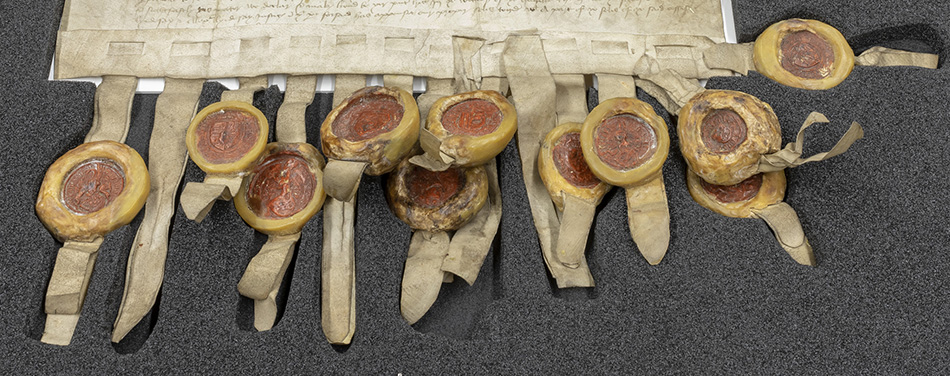Defining the boundaries: protection through housing and minimizing handling

Within the Burgh of Cupar charters collection (B13) is a document dated 5 April 1487 recording the marking of the boundaries of land belonging to the Burgh of Cupar and that of George Claphaine of Kerslogy [Carslogie]. The boundaries were perambulated or walked along in the presence of witnesses and recorded in the deed, so that there could be no dispute in the future. The description of the document reads:
“Perambulation in presence of David, lord Lyndessay of the Byris, Andrew, lord Gray, and Alexander Lyndesay of Ochtirmonsy, justiciars in that part to perambulate the Marches between the lands pertaining to the aldermen, bailies and community of the burgh of Cupar and the lands pertaining to George Claphaine of Kerslogy, according to a compromise made between them in presence of witnesses.
Fine, you may say, but there are other documents earlier than this going back to 1364, so what’s so special about this one? Ah, well this one has attached to it 11 pendant seals, all intact! There were originally 15 seals but four are missing. The Archives Revealed project Hidden Burgh: Restoring Cupar’s place at the heart of Fife includes conservation and preservation of those documents requiring specific attention, and this document was certainly in need of that!
The Cupar Burgh charter is written in iron gall ink on a parchment support. The bottom edge of the parchment document has been folded up, and horizontal slits cut into the parchment. Double strips of parchment passed through the slits form tabs onto which wax seals have been attached. This method of seal attachment is known as sur double queue or ‘on a double tail’ – the parchment tabs being the tails. Iron gall ink manuscript on the inside of some of the ‘double parchment tails’ shows the reuse of a redundant parchment document to make the tabs on this charter. The centre of the seal impressions are in red wax, likely to be coloured with vermillion, and the surrounds are uncoloured natural wax, now rather discoloured.
Parchment documents can be difficult to handle in themselves, especially when they have been stored folded and the parchment fibres stiffen or shrink in areas through ageing. Pendant seals add to the difficulty of handling documents, exacerbated in this Burgh Charter with its 11 seals.
On receipt the charter was folded, the fold lines can still be seen in the parchment. The uncoloured white wax around the seal impressions was crumbly, the parchment tabs were stiff and retained the tendency to fold in towards the document and the parchment support had areas of yellowing and translucence indicating chemical deterioration of the parchment fibres.
Aqueous treatment could not be used to humidify and flatten the document without the risk of causing further gelatinization of the degraded parchment. A non-aqueous treatment was therefore chosen. The cleaned charter was flattened over several months using magnets.
To minimise the need for handling, the document has been rehoused in a format which can also be used for display or access. The charter has been sink mounted into black plastazote (closed cell polyethylene foam blown with nitrogen) which is fitted into a custom fluted archival board tray. Five of the seals have been folded in towards the charter, which is protected by a thin white plastazote, and wrapped in ‘Sontara’™ (a polyester felt webbing). A final layer of black plastazote fills out the negative space above the charter and around the raised seals. The tray is topped with a layer of double-wall archival fluted board and enclosed in a custom 300 gsm archival cover paper four-flap folder.
Rachel Hart says:
“This new packaging means that the charter can easily be produced for use in class as an excellent example of a document bearing multiple seals. Our medieval palaeographers get to see a wonderful document without risk of damage to the original and also can appreciate some superb work done by our conservator.”
Christine Wood
Project Archivist (Archives Revealed)
Erica Kotze ACR
Preventive Conservator

[…] of the preservation work carried out can by found in the Echoes from the Vault blog post entitled “Defining the Boundaries: Protection through housing and minimizing handling”. The work on this charter has been made possible because of the prioritization of the Cupar records […]